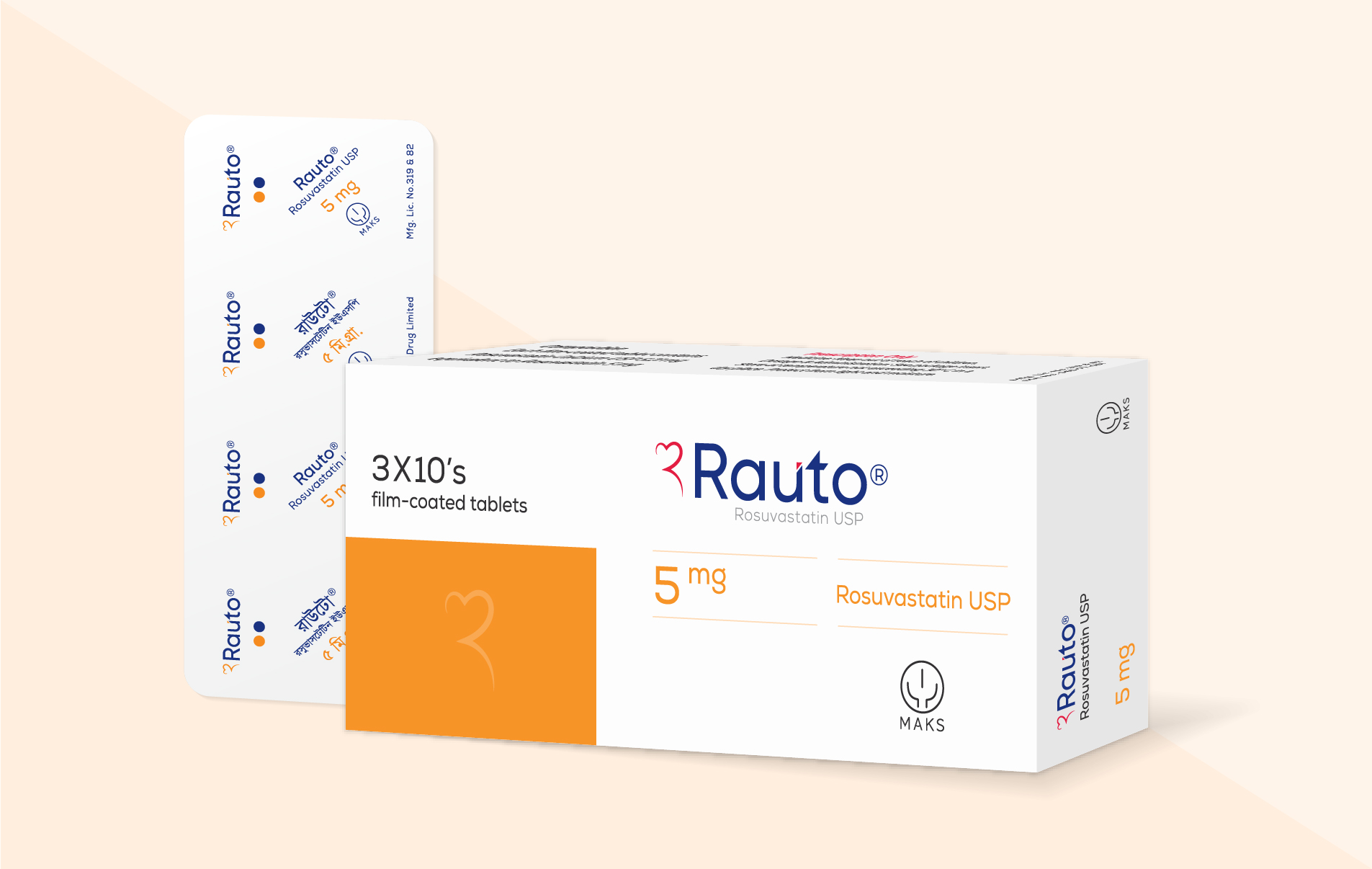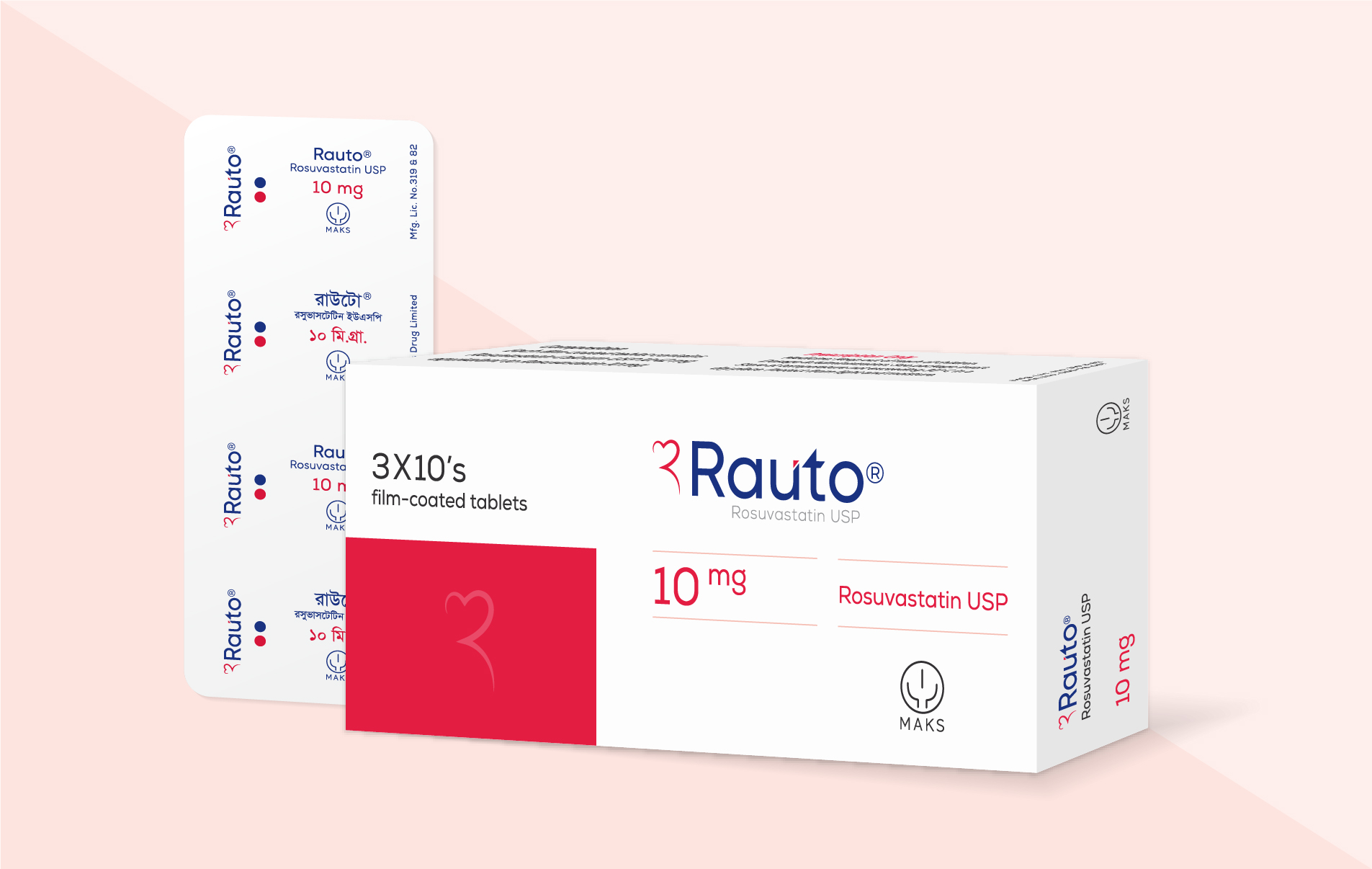Rauto (Rosuvastatin)
Therapeutic Group: Cardiovascular
Rauto® 5 mg Tablet: Each tablet contains Rosuvastatin Calcium USP 5.21 mg equivalent to Rosuvastatin 5 mg.
Rauto® 10 mg Tablet: Each tablet contains Rosuvastatin Calcium USP 10.42 mg equivalent to Rosuvastatin 10 mg.
Rosuvastatin
calcium is a synthetic lipid-lowering agent. Rosuvastatin is an inhibitor of
3-hydroxy-3-methylglutaryl-coenzyme A (HMG-CoA) reductase. This enzyme
catalyzes the conversion of HMG-CoA to mevalonate, an early and rate-limiting
step in cholesterol biosynthesis.
• Patients with
primary hyperlipidemia & mixed dyslipidemia as an adjunct to diet to reduce
elevated total-C, LDL-c, ApoB, non-HDL-c & TG levels & to increase
HDL-c, • Patients with hypertriglyceridemia as an adjunct to diet, • Patients
with primary dysbetalipoproteinemia (Type III hyperlipoproteinemia) as an
adjunct to diet, • Patients with homozygous familial hypercholesterolemia
(HoFH) to reduce LDL-c, total-c and ApoB, • Slowing the progression of
atherosclerosis as part of a treatment strategy to lower total-c & LDl-c as
an adjunct to diet, • Pediatric patients 10 to 17 years of age with
heterozygous familial hypercholesterolemia (HeFH) to reduce elevated total-c,
LDL-c & ApoB after failing an adequate trial of diet therapy, • Risk
reduction of MI, stroke & arterial revascularization procedures in patients
without clinically evident CHD, but with multiple risk factors.
5-40 mg once
daily with or without food at any time of the day. 40 mg only for patients not
reaching LDL-c goal with 20 mg. In pediatric patients 10-17 yrs of age with
HeFH, the usual dose range is 5-20 mg/day; doses greater than 20 mg have not
been studied in this patient population.
Rosuvastatin is
generally well tolerated. Adverse reactions have usually been mild and
transient. 3.7% patients discontinued the therapy due to adverse experiences
attributed to Rosuvastatin. The most frequent adverse events thought to be
related to Rosuvastatin were myalgia, constipation, asthenia, abdominal pain
and nausea.
Before
instituting therapy with Rosuvastatin, an attempt should be made to control
hypercholesterolemia with appropriate diet, exercise, and weight reduction in
obese patients and treatment of underlying medical problems. Administration of
Rosuvastatin 20 mg to patients with severe renal impairment (CLcr<30
ml/min/1.73 m2) resulted in a 3-fold increase in plasma concentrations compared
with healthy subjects.
Rosuvastatin
clearance is not dependent on metabolism by cytochrome P450 3A4 to a clinically
significant extent. This is confirmed in studies with known cytochrome P450 3A4
inhibitors (Ketoconazole, Erythromycin, Itraconazole).
Ketoconazole:
Coadministration of ketoconazole with Rosuvastatin (80 mg) resulted in no
change in plasma concentration of Rosuvastatin.
Erythromycin:
Coadministration of erythromycin with Rosuvastatin (80 mg) decreased AUC and
Cmax of Rosuvastatin by 20% and 31% respectively. These reductions are not
considered clinically significant.
Itraconazole:
Itraconazole resulted in a 39% and 28% increase in AUC of Rosuvastatin after 10
mg and 80 mg dosing respectively. These increases are not clinically
significant.
Fluconazole:
Coadministration of fluconazole with Rosuvastatin (80 mg) resulted in 14%
increase in AUC of Rosuvastatin. This increase is not considered clinically
significant.
Cyclosporine:
Coadministration of cyclosporine with Rosuvastatin resulted in no significant
change in cyclosporine plasma concentrations.
Warfarin:
Coadministration of warfarin (20 mg) with Rosuvastatin (40 mg) did not change
warfarin plasma concentrations.
Digoxin:
Coadministration of digoxin (0.5 mg) with Rosuvastatin (40 mg) resulted in no
change to digoxin plasma concentrations.
Fenofibrate:
Coadministration of fenofibrate with Rosuvastatin (10 mg) resulted in no
significant change in plasma concentrations of Rosuvastatin or fenofibrate.
Antacid:
Coadministration of an antacid (aluminium and magnesium hydroxide combination)
with Rosuvastatin (40 mg) resulted in a decrease in plasma concentrations of
Rosuvastatin by 54%. However, when antacid is given 2 hours after Rosuvastatin,
there is no clinically significant change in plasma concentrations of
Rosuvastatin.
Oral
Contraceptives: Coadministration of oral contraceptives (ethinyl estradiol
and norgestrel) with Rosuvastatin resulted in an increase in plasma
concentrations of ethinyl estradiol and norgestrel by 26% and 34% respectively.
There is no
specific treatment in the event of overdose. In the event of overdose, the
patient should be treated symptomatically and supportive measures instituted as
required. Hemodialysis does not significantly enhance clearance of
Rosuvastatin.
Store at
temperature not exceeding 30º C in a dry place. Protect from light and
moisture.
Rauto® 5 mg Tablet: Each box contains 3x10’s tablets in Alu-Alu blister stips.
Rauto® 10 mg Tablet: Each box contains 3x10’s tablets in Alu-Alu blister stips.



